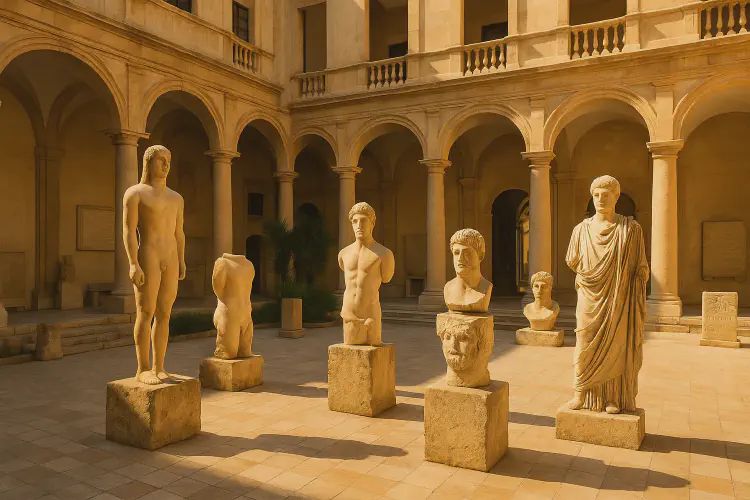Best museums in Sicily
Sicily’s museums preserve more than 3,000 years of history — from Greek temples and Roman villas to Arab-Norman art and modern masterpieces. Exploring them is like tracing the island’s entire cultural DNA, one civilization at a time.
- Visit Sicily
- 3 min read

Best Museums in Sicily — A Journey Through Time
🏛️ Overview
Few places in the world can rival Sicily for historical depth. Its museums showcase the island’s extraordinary blend of Greek, Roman, Arab, Norman, and Baroque heritage, alongside rich collections of archaeology, art, and folklore. Whether you’re a history enthusiast or casual traveler, these museums provide a vivid window into the civilizations that shaped the Mediterranean.
🏺 1. Regional Archaeological Museum Antonio Salinas (Palermo)
Located near Piazza Olivella, Palermo’s Museo Archeologico Regionale is one of Italy’s finest archaeological collections.
- Highlights include Greek metopes from Selinunte, Phoenician artifacts from Motya, and Etruscan and Roman sculptures.
- The cloistered courtyard and Arabic-style architecture make the museum itself a historical treasure.
Must-see: The monumental Temple E metopes from Selinunte, carved around the 5th century BCE.
🏛️ 2. Paolo Orsi Archaeological Museum (Syracuse)
Named after the archaeologist who excavated much of eastern Sicily, this museum holds artifacts from prehistoric to Roman times.
- Displays include items from Greek Syracuse, Pantalica necropolis, and ancient Akrai.
- Features stunning archaic kouroi statues and bronze helmets from classical battles.
Must-see: The Medusa head from Gorgoneion, one of Sicily’s most iconic Greek relics.
🏺 3. Regional Archaeological Museum of Agrigento (Pietro Griffo Museum)
Located near the Valley of the Temples, this museum connects directly to the ancient city of Akragas.
- Exhibits over 5,000 artifacts, including temple fragments, pottery, and sculptures.
- Offers an in-depth look at everyday Greek life in Agrigento.
Must-see: The colossal Telamon (Atlante) from the Temple of Zeus Olympios.
🧩 4. Villa Romana del Casale Museum (Piazza Armerina)
A UNESCO World Heritage Site, this 4th-century Roman villa is itself an open-air museum of mosaics.
- Houses over 3,500 square meters of preserved mosaics, depicting mythological scenes, hunting, and daily life.
- The famous “bikini girls” mosaic is a highlight of Roman artistry.
Must-see: The Great Hunt Mosaic, a sprawling depiction of exotic animals and hunters across continents.
🖼️ 5. Regional Museum of Messina (Museo Interdisciplinare Regionale di Messina)
After much of Messina’s art was lost in earthquakes, this museum preserves the city’s artistic legacy.
- Features paintings by Caravaggio, Antonello da Messina, and local Baroque masters.
- Includes sculptures rescued from ruined churches.
Must-see: Caravaggio’s “The Adoration of the Shepherds” and “The Raising of Lazarus”.
🐚 6. Pepoli Regional Museum (Trapani)
Housed in a former Carmelite monastery, this museum showcases the artistry and craftsmanship of western Sicily.
- Known for coral jewelry, silverwork, and religious art.
- Explores local traditions and maritime culture.
Must-see: The Trapani coral crucifixes and rosaries — delicate works of devotion.
🧵 7. Museo delle Trame Mediterranee (Museum of Mediterranean Weaves), Gibellina
A modern cultural museum dedicated to Mediterranean identity and dialogue.
- Combines art, photography, and anthropology to highlight Sicily’s role as a crossroads between Europe, Africa, and the Middle East.
- Part of the wider Gibellina Contemporary Art Park, rebuilt after the 1968 earthquake.
🧭 Summary
Sicily’s museums tell the story of a crossroads civilization — where East met West, and ancient met modern. From the Greek temples of Agrigento to the Roman mosaics of Piazza Armerina, from Caravaggio’s canvases to Islamic coral craftsmanship, each museum reveals another layer of the island’s rich, diverse soul. Visiting them is like walking through 3,000 years of Mediterranean history, all contained within one remarkable island.